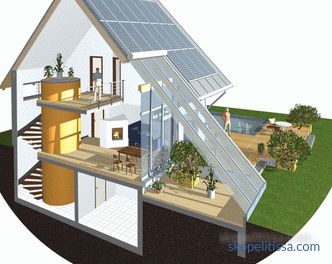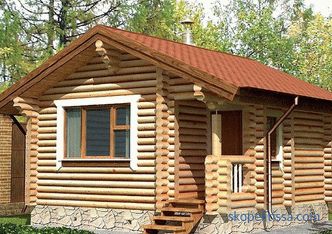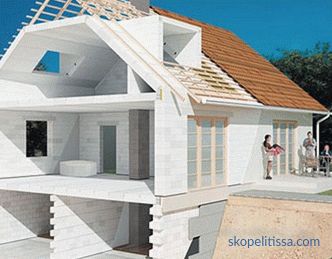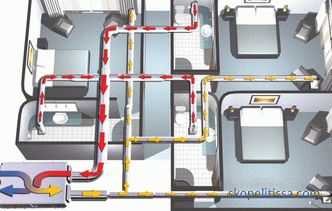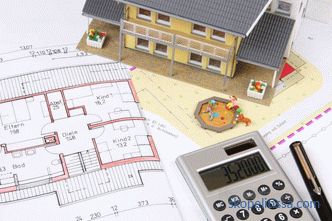The ecology of large cities, with wide transport interchanges and numerous industries, leaves much to be desired. Many city dwellers chose brick and panel apartment buildings for the blessings of civilization. Now, when the benefits of civilization are not associated with apartment buildings, they seek to acquire housing closer to nature, and make the house of the most natural materials. On the last point, out of competition wooden houses, which were and remain one of the most comfortable for living.
Among all types of private housing built of wood, particular attention is drawn to the houses of laminated veneer lumber. It is believed that this material shows the best qualities of wood, and the disadvantages are leveled by technological processing.
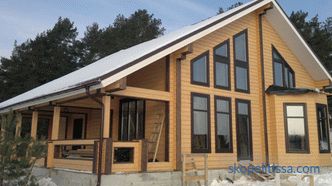
The evolution of technology
The production technology of laminated veneer lumber did not appear on the empty place. Long before the appearance of the first country houses assembled from this building material, similar wood processing methods were used in different parts of the world and in different eras. As a result, craftsmen from several individual plates or rods received durable parts with characteristics inaccessible to products from a single piece of wood. The following methods of use are widely known:
-
Manufacturing technology of combat bows in Japan . In the 12th century not only samurai appeared in the country, but also new multi-layer (composite) bows. Durable reinforced weapons (service life was estimated for decades, and the bow was often indulged by inheritance) was obtained after gluing wooden and bamboo fragments.
-
Construction technology of palace arched structures . French architect Philibert Delorme, the author of an incomparable bridge at the Château de Chenonceau, was the first to guess to join wooden bars with a wedge. Similar bent bearing parts were used in Russia in the construction of churches, noblemen and merchant houses.
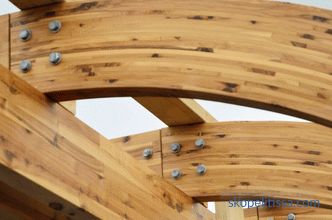
-
Production technology bent glued trusses . A patent for this invention in 1890 received a German carpenter Otto Hetzer. He began to produce massive multilayer structures, combining fragments of casein glue.
-
Production technology of modern materials . The impetus to the spread and construction of houses from glued laminated timber was the development of the chemical industry, which launched the production of a wide range of adhesives for different operating conditions.
The essence of technology
House-set production is carried out in accordance with the project of the future house. Glued laminated timber is a product of a high-tech chain consisting of several successive stages:
-
Preparation of raw materials . Wood undergoes strict quality control, sorted by physical and mechanical properties; poor quality raw materials (with visible defects) is rejected. This selection of material takes place at each stage.
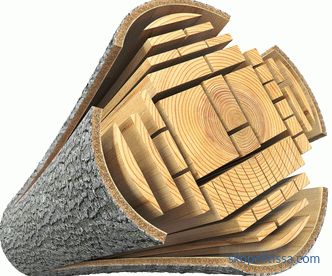
-
Log cut is boards . For the manufacture of high-quality laminated veneer lumber used boards (slats) longitudinal, radial or semi-radial sawing. Small companies acquire ready-made lumber, large manufacturers have their own sawmill. To reduce the loss of wood sawing is carried out on modern equipment with computer control. Depending on the size of the logs, a smart machine selects the optimal cutting scheme.
-
Drying . Can be performed in natural conditions, but chamber drying is preferred. Responsible stage, determining the properties of future lumber. Diligent manufacturer dries the workpiece in a soft, gentle mode; it takes more time, but it allows to level the level of humidity and reduce internal stress, due to which ready-made bars can be bent. Computerized equipment allows you to monitor and regulate the moisture content of wood right in the drying chambers. The glued laminated timber composed of such lamellas will not be subject to warping or cracking.
-
Putting glue . After preprocessing (gouging and trimming) glue is applied. Various compositions are used, but all of them are necessarily certified for such works.
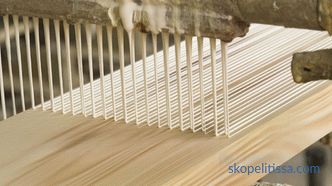
-
Pressing . Dried lamellae (with a moisture content of 8–12%) are collected according to a scheme (often of several wood species, to give extra strength) into bags. The cross section of the beam can be varied in a significant range, which does not change the characteristics of the product. Then the workpiece is pressed and maintained under pressure until fully glued.
-
Processing . The glued blanks go through surface gauging (treatment that gives the surface smoothness).
-
Milling . After sorting by strength, the bars are profiled and cut to the required length. Landing bowls (longitudinal grooves of heat locks), openings for communications and pins (hairpins) are cut into them in a delicate manner.
-
Finishing work . The set of timber is treated with antiseptics, marked and packaged.
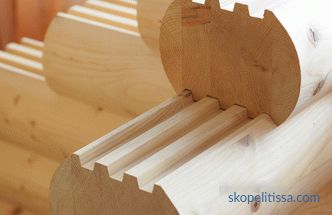
Technology nuances
Glued physical characteristics timber significantly exceed the performance of conventional wood or even profiled timber. The first "popularizers" of the technology were Finnish houses from laminated veneer lumber, which are famous for their reliability and durability and are almost the standard of wooden house-building. The quality of the material used in the construction is the result of a fairly complex and thorough processing of the raw materials, which takes place in several stages with strict quality control.
Choice of wood
For the production of material, coniferous trees are considered optimal, including:
-
Pine . The most affordable (due to the rapid growth of trees) and therefore popular material. The best wood has pine, which is brought from the northern forests - Arkhangelsk, Karelian, Angarsk.
-
Spruce . Possesses ideal for construction wood; it is used both for bearing walls, and for partitions, floors and doors. The drawbacks that push the fir-tree to the second place are the increased knotty and smollinost of wood; besides, the spruce loses to the pine in terms of growth and whimsically behaves when drying (it can be jarred).
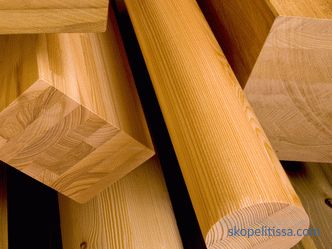
On our website you can familiarize yourself with the most popular projects of glued houses timber from construction companies presented at the exhibition "Low-Rise Country".
-
Larch . Wood is second only to oak in hardness, it is firmly resistant to decay, and thanks to a special resin with antiseptic properties, it is protected from infection by mold, fungus and tree borers. Due to such properties, larch timber is a valuable building material.
-
Cedar . Wood saturated with essential oils has been valued since ancient times (mentioned in the Bible) and is similar in properties to larch wood, only less dense. Cedar wood is valued for its beauty and is in high demand, although not cheap.
-
Oak . Although not coniferous, it has a beautiful texture, durability and resistance to decay. Over time, wood acquires a noble shade and, as a rule, is used for the manufacture of external lamella beams.
About the advantages of glued laminated timber in the following video:
It might be interesting! In the article on the following link read about the difference between glued and profiled bar.
Craft production
The Internet offers quite a few special articles devoted to the handicraft production of laminated veneer lumber and the construction of houses from it. The main factor prompting to pay attention to such a house of laminated veneer lumber - the price, which is attractive (and sometimes implausible) is low. Customers looking for low cost options should remember that:
-
For the manufacture of 1 m 3 glued laminated timber 2 m 3 boards are used (and not construction, and a special drink, from the best parts of the tree trunk). Such lumber is not cheap.
-
In order for the timber, after six months of operation (and sometimes earlier), not to become stratified along the lamellae, it is glued together with high-quality (not cheap) glue.
-
For the production of a good (dense, without gaps) locking connection, a high-tech (preferably foreign-made) machine is needed, and with it a qualified performer.
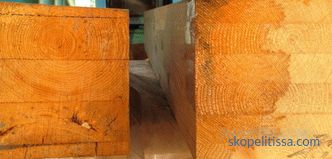
The recipe for a cheap glued beam looks like this:
-
A cheap forest , sieve (with rot) or burnt wood is bought. It is dried in unregulated conditions and transported, regardless of humidity and rain. A timber made from such raw materials immediately begins to rot.
-
Cheap glue is purchased. Even if the timber does not fall apart after half a year, it will become the cause of incomprehensible headaches and allergies in the household.
-
An old is purchased or rented (production should be as profitable as possible) tools. The gaps are foamed, the mismatched parts are attracted by a sledge hammer, the press in a cold shed is blown by a heat gun. A cold board must be glued (albeit briefly).
A real glued timber cannot be made in artisanal conditions, and it cannot be cheap by definition - it is an axiom that does not require proof. The houses from a turnkey glued timber, made of qualitative material, can be cheaper than analogues in the event that they are intended for seasonal living.
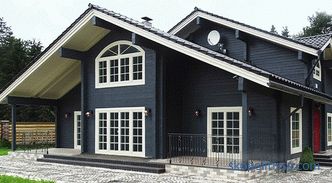
Projects and prices of houses from glued lumber
to join the army of those who multiply negative reviews about the glue beam on the Internet, do not save, once you have chosen such a building material. Bar prices are as follows:
-
Domestic wall glued bar . The range starts from 18-22 thousand rubles. and rests on 30-35 thousand rubles. / m 3 .
-
Finnish material . The cost reaches 45-50 thousand rubles. / m 3 .
The cost of a domokomplekt lies in the range of 9.5-18.5 thousand rubles. / m 2 , which affects the complexity of the project, the characteristics of materials and equipment. Choosing a project, you should understand that the price tag may indicate different offers:
-
Indicates the price of the timber , and turning it into a country house is paid additionally.
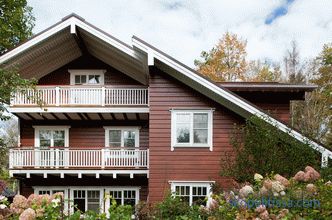
-
The price is indicated ready domkomplekt , the amount depends on the set of elements. The price of the finished house on an individual project starts from 50 thousand rubles. / m 2 .
Average prices for turnkey glued timber houses (Moscow region) are as follows:
-
Houses with an area up to 100 m 2 : 2.6-3.7 million rubles.
-
By the area from 100 to 200 m 2 : 3.89-5.65 million rubles.
-
From 200 to 300 m 2 : 6.8-9.5 million rubles.
It can be interesting! In the article on the following link read about the interior design of the house of laminated veneer lumber.
Conclusion
Wooden houses from glued timber were recognized in many countries of the world, the technology is recognized as efficient and economical. Such housing delights its owners with the quality of performance, functionality, aesthetic expressiveness and economy in operation. Only if high-quality gluewood was used for its construction, and the construction company was engaged in construction with a decent experience in the field of wooden housing construction.
